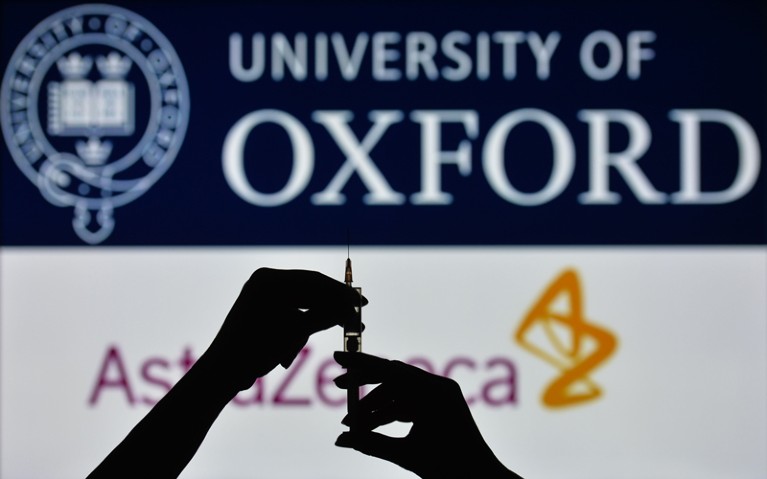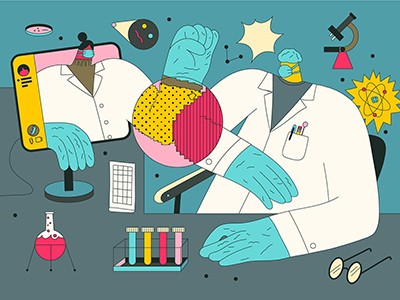
Credit: Cezary Kowalski/SOPA Images/Shutterstock
The pandemic has created a new kind of household name: AstraZeneca, BioNTech, Moderna and Pfizer are now as familiar as soap brands. But their life-saving vaccines would not have become a reality without remarkable and rapid collaboration with researchers at universities.
As part of this week’s special issue on research collaborations, Nature spoke to industry scientists about their experiences of collaborating with academic colleagues on vaccine development. Collaboration between academia and industry is well established in many parts of the world. But the speed and scale of achievement during the pandemic — globally, 16 vaccines have been approved so far, with a further 9 in full phase III clinical trials — is rare, if not unprecedented, and interviewees praised the energy, enthusiasm and can-do attitude that they found in universities. Moreover, collaborating in the face of relentless media scrutiny as the world waited for a vaccine breakthrough has not been easy, interviewees added.
Research collaborations bring big rewards: the world needs more
Unsurprisingly, respondents noted the limitations that virtual communication and lockdown restrictions have imposed on collaboration. They also urged more clarity on ownership of data and of intellectual property (IP) — areas where discussions with academic colleagues have been difficult.
This isn’t new. Data ownership and intellectual property are sources of long-standing tensions in the academia–industry relationship. But there are ways these tensions can be eased.
The scientists Nature spoke to for this editorial say there have been robust exchanges with universities about how to apportion intellectual property when discussing collaborations. It’s clear that some were not expecting that universities would also be thinking about monetizing their science; there remains a perception among some in industry that universities produce the science, and leave industry to commercialize it.
Universities do negotiate hard to maximize the returns on their science, effectively creating competition between universities and companies — something that did not exist in previous decades. And yet, there might be a silver lining. The campaign for time-limited IP relief on COVID-19 vaccines, backed by more than 100 countries, the World Health Organization and both China and, crucially, the United States, could help to reduce IP disputes with universities, at least when it comes to collaboration on COVID-19 vaccines. Industry is against the campaign, but if it drops its opposition, more knowledge will become public, and at least some barriers to collaboration will disappear.
A white-knuckle ride of open COVID drug discovery
Access to data is another area where collaboration could be improved. For example, there need to be better mechanisms for researchers to access industry data in emergencies. These were discussed ahead of last week’s meeting of the G7 group of some of the world’s biggest economies in Cornwall, UK, and might form part of a planned pandemic treaty. But solutions for data access also need to be found for collaborations to thrive outside of emergencies such as pandemics. Not all pharmaceutical-industry data that researchers can use is commercially sensitive. Other industries, such as finance and telecommunications, have similar challenges and experiences in data sharing, all of which need to be studied.
Dismantling barriers
Clearly, industry and academic colleagues have worked together at speed to deliver vaccines, underpinned by public and charitable investment; one analysis of the Oxford–AstraZeneca COVID-19 vaccine that has not yet been peer reviewed showed that 98% of identified funding came from these sources (S. Cross et al. Preprint at medRxiv https://doi.org/ghwh; 2021).
Collaborations of this kind must continue beyond the pandemic. But, alongside goodwill, they will also require progress on ownership of data and IP.
How the COVID pandemic is changing global science collaborations
The pandemic has boosted public awareness of science–industry partnerships. It has also led to greater public understanding of research, manufacturing and quality-assurance processes. “People are hearing scientists talk. Taking them out of the labs is a new and now-accepted thing,” one industry representative told Nature.
Researchers need to study how this happened, in part to build on successes, and also to learn lessons for future pandemics, and to nurture the collaborations needed to tackle them. Researchers in academia and industry — and not only those who study infectious diseases — should now be looking to expand collaborations beyond the pandemic.
Success has also created expectations, in particular that academia and industry will deliver when called on. But future successes are not guaranteed, as both university- and industry-based researchers know. That is why every lesson from this pandemic must be learnt, and barriers to collaboration must be dismantled as much as possible.

 Research collaborations bring big rewards: the world needs more
Research collaborations bring big rewards: the world needs more
 How the COVID pandemic is changing global science collaborations
How the COVID pandemic is changing global science collaborations
 Community–academic partnerships helped Flint through its water crisis
Community–academic partnerships helped Flint through its water crisis
 A white-knuckle ride of open COVID drug discovery
A white-knuckle ride of open COVID drug discovery
 The authorship rows that sour scientific collaborations
The authorship rows that sour scientific collaborations
 ‘We need to talk’: ways to prevent collaborations breaking down
‘We need to talk’: ways to prevent collaborations breaking down
 Tapping local knowledge to save a Papua New Guinea forest
Tapping local knowledge to save a Papua New Guinea forest





